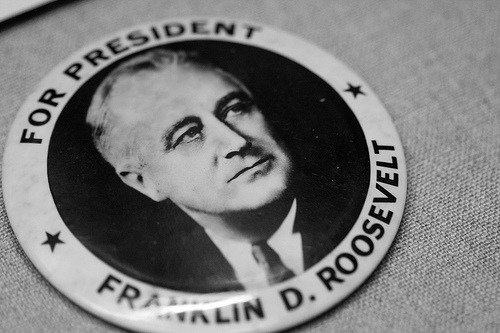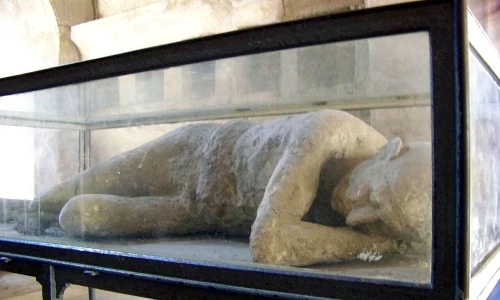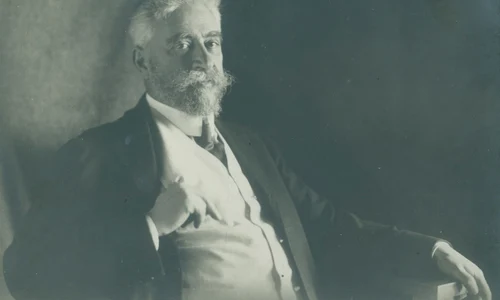
Franklin Delano Roosevelt, the New Deal and American Politics
Franklin Delano Roosevelt is known for his unique four terms as the President of the United States and for being the one who challenged the isolationistic trend and finally engaging Washington in the WW2. However, when he first came into the office, FDR had to deal with the after effects of the Great Depression and his Administration had to devise a new type of policy, in order to bring about a change after the recession and to restore the confidence in the Government.

Americans were completely dissatisfied with the Republican policy and therefore, the promises Roosevelt made helped him come into the office with the enormous backing of the people who elected him. Moreover, he was determined to keep up the promises he made during the campaign and bring forth a redemption to the four years when the US seemed to get off the track of becoming the next super power. Moreover, because of the gold standard, the recession which started on Black Tuesday in late October 1929 sent shockwaves across the world and created an unfathomable atmosphere of insecurity at a global level.
Yet, unlike other countries such as Weimar Germany or Japan, the recession did not cause a sudden surge in the authoritarian or totalitarian feelings in Washington, yet it translated into the fact that the federal state was more involved in daily policy. FDR’s Presidency offered an alternative to what was considered a normal Presidency until then:he and his advisers were convinced that the state should offer more than just a framework to the society and they did just that.
In his famous first 100 days in the office, Roosevelt attempted to do what nobody ever did in the history of the US:to do away with what was happening at the time in the US with unemployment, strikes and general unhappiness. The Congress passed almost all of his programs and a few he opposed thus making him a standard for the next Presidents – they were to be judged in comparison with FDR and what he achieved in his 100 days at the White House.
However, what FDR and his Administration tried to do was unique and became a turning point in how the Americans perceived their relation with the State. Roosevelt managed to create a better bond with the people who elected him and thus, they started to believe that it was their responsibility as well to be in touch with what was happening in Washington. Thus, FDR used the radio – the newest technology at the time – to his advantage:his press conferences were broadcast live as well as his fireside chats and he was constantly interested in the trends of public opinion, so as to calibrate his Administration’s policies to them.
The New Deal offered a first important glimpse into what a welfare state may mean:in times of economic recession and other types of ultimate difficulties for a society, the state could have a more hands-on approach and thus, devise programs to help its people. The New Deal was built on the Keynesian theme of injecting money into the economy, in order to restart it. He asked the Congress to abolish the Prohibition, which was a very divisive issues in the 1920s, yet under his Presidency, he decidedly won the Congress to his side.
His Administration also passed a law – National Industrial Recovery Act – which allowed the workers to create unions and negotiate for bigger wages and better working conditions. Moreover, they suspended a part of the anti-trust laws and created a Public Works Administration founded by the federal state. FDR also managed to pass in the Congress the Agricultural Adjustment Act, the Tennessee Valley Authority Act as well as Glass-Steagall Banking Bill and the Home Owners’ Loan Act. All of this meant creating jobs for people which determined the steady decrease in unemployment, trying to get the economy back on track and it also led to a point where everybody found something to be satisfied with in FDR’s policies.

Although the New Deal passed some very important laws and changed somewhat the idea of what a federal state should be, the unemployment persisted well into 1935 and people became again impatient. This time, FDR launched a new, more aggressive New Deal:Works Progress Administration was created and again, jobs were offered to those who were unemployed and also to artists, directors, performers etc. This WPA was not allowed to compete with the private industry. Also, in 1935, National Labor Relations Act enabled the National Labor Relations Board which was to supervise the working conditions of the people and to prevent them being badly treated.
Another very important legislation was the Social Security Act which was an important step towards building a social system which offered a better life conditions for millions of Americans:pensions, money for the unemployed and aid for dependent children and the disabled. Yet, by 1937, the effects of the Great Depression could still be seen in the US. For instance, in 1936, there was a 44-day strike at a General Motors plant in Flint, Michigan which spread to 150, 000 workers in 35 cities. In 1937, there was a feeling that maybe the New Deal had flopped and the Constitutional Court invalidated some initiatives such as the NRA and the AAA. In the same year, the American economy slumped back into recession. Ironically, only Washington’s entanglement in the WW2 managed to stimulate the industry and it effectively did away with the Great Depression.

Yet, FDR’s effect on American politics went beyond the beginnings of the welfare state. He managed to create a brand-new, if tenuous, political coalition that included white working people, African Americans and left-wing intellectuals who shared a powerful belief that an interventionist government was good for their families, the economy and the nation. Their coalition has splintered over time, but many of the New Deal programs that bound them together–Social Security, unemployment insurance and federal agricultural subsidies, for instance–are still with us today.[1]Therefore, FDR’s impact should be seen as going well into the core of the American political regime where the President and his Administration gradually gained more power whereas the federal state was concerned.
[1]http://www.history.com/topics/new-deal
















